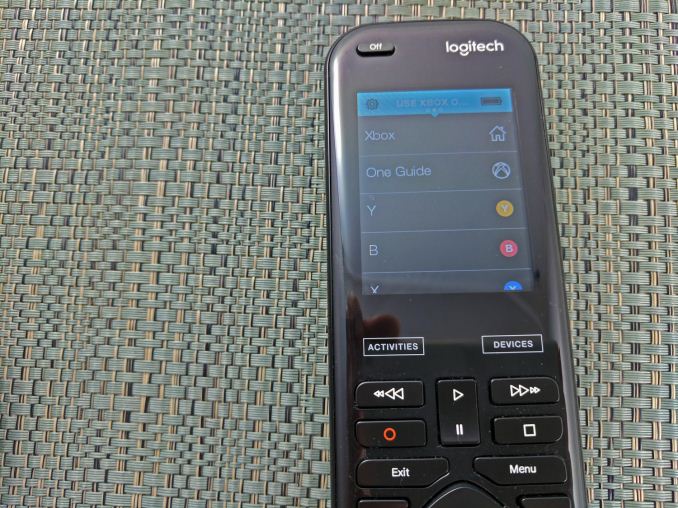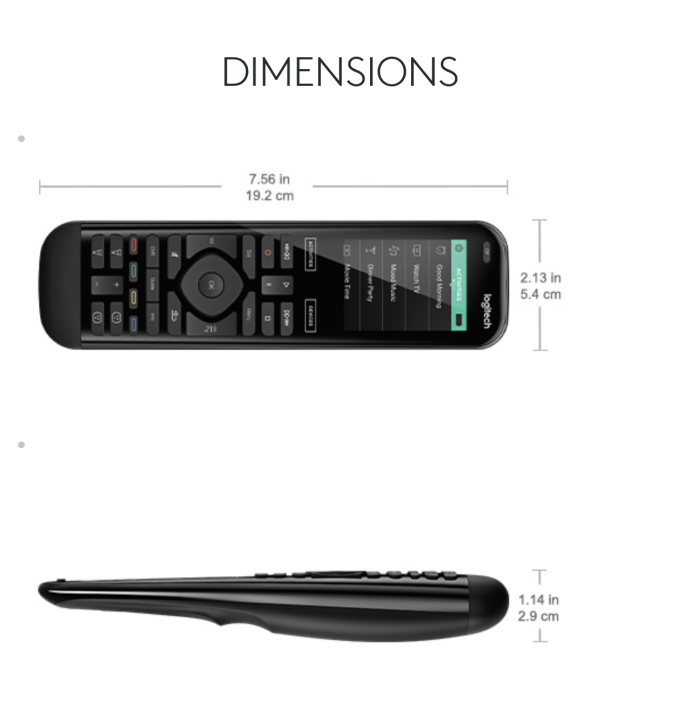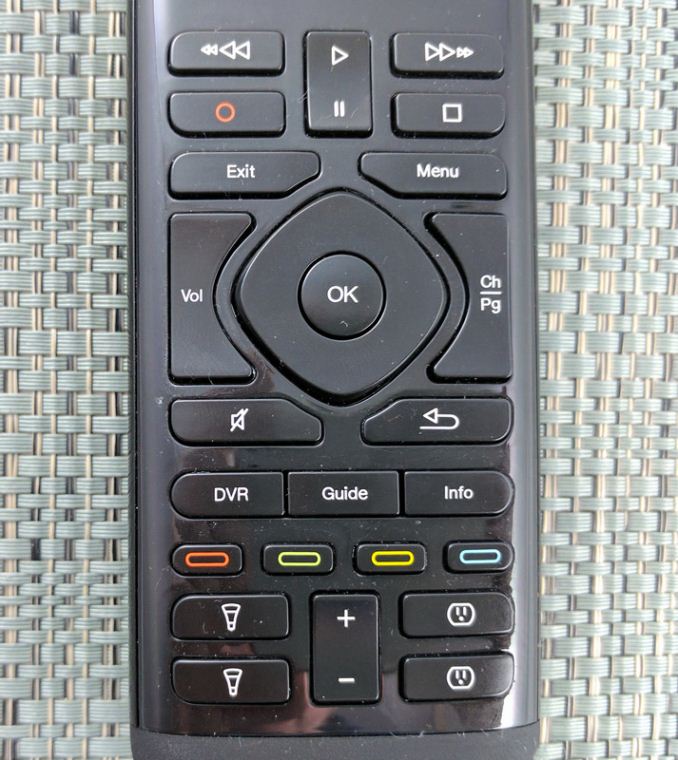The Logitech Harmony Elite Experience: Ultimate Control
by Brett Howse on February 14, 2017 8:00 AM EST- Posted in
- Accessories
- Logitech
- Remote Control
- IoT
- Smart Home
- Harmony
The Logitech Harmony Elite Remote
Before we dig into the software side, let’s first look at the part of the Harmony Elite system you will more than likely use the most, and that is the remote itself. Logitech has meandered over the years in terms of remote design, and they have been putting screens onto remotes for over a decade already, but the Elite is the best design they have ever come up with.
Touchscreens are something we now use every day, but that doesn’t mean they are always the best use case for a given situation. The biggest downside to a touchscreen is that it forces users to interact with it by first looking at it. That might sound obvious, but it’s one of the biggest detractors from a touchscreen as well. Forcing someone to look at a screen can make a simple task into a complex one, at best. At worst, they can be outright dangerous in some scenarios like in a car, where many manufacturers have forgotten that sometimes it’s important to be able to turn on the defrost without going through five menus first. The car scenario is perhaps a stretch when discussing something like a remote control, but the same principles are in effect. Touch requires the user to divert their attention, focus on a screen, ensure the screen is showing the correct options, and then touch it in the right location, where there is little to no feedback that the correct option was touched.
Logitech has made some poor choices over the years with Harmony remotes, to the ultimate (pun intended) mistake of the Harmony Ultimate. This remote featured a touchscreen in the very center of the remote, between the volume and navigation buttons, and the transport buttons. It was an insane decision. Luckily, Logitech has seen the error of their ways, and they’ve now situated the touchscreen at the top of the remote, where it is less likely to be accidentally pressed.
Let’s talk about the screen itself. It’s a 1.5-inch diagonal display with a whopping resolution of 128x128. It can display 65,000 different colors. Considering the use model for the display, it’s adequate, but that is the best thing you can say about it. A sharper screen would go a long way to make the Elite look a bit more premium, especially for the price. The colors are washed out, and the text is pixelated, but at the end of the day, it does function well. For most interactions, the screen is mostly used to choose activities, and to use less-used buttons, so the touchscreen works well in this scenario, since you end up using it less. On a remote control, one of the keys is not needing to look at it, after all. Still, a better display would be one way Logitech could step up their game.
The remote itself is very well designed. The top is a smooth, glossy, black plastic that is pleasing to look at, while the underside is a coarse texture that prevents the remote from slipping out of your hand. It measures 54 mm wide, by 29 mm deep, by 192 mm high (2.13 x 1.14 x 7.56 inches) and unboxing the remote, the short height was one of the first things I noticed. It is significantly shorter than the Harmony One it was replacing. It also weighs 164 grams (5.8 oz) which makes it feel solid, but doesn’t give you any sort of fatigue in use, and most of the weight is near the bottom, meaning it is easier to hold in your hand.
The smaller remote was achieved by removing many of the buttons off the remote, which might sound like a disaster, but in fact, it was very well thought out. The number pad was moved to the touch screen, which is likely the only casualty that will really be noticed, but those were buttons that I never used often so I don’t miss them at all. Other buttons were removed, such as skip, and those could be an issue, except that the Elite allows all buttons to offer two controls. Press is one, and press and hold for a second is another, so skip and fast forward now share the same button (unless you change it of course, since you can). By default, fast forward was press, and skip was press and hold, but in my home that is the opposite of how I would use it, so I swapped them around.
In fact, the removal of buttons has made the remote somewhat easier to use. As an example, delete on my DVR was a button beside the zero on the number pad. With the Elite, it is programmed to be a long press on Stop, which is much easier to access.
Regardless, shrinking the remote has made it more comfortable to use, and much easier to access all the buttons that are there. It really was a smart move. The new buttons are also just the right amount of click, and are an improvement over the Harmony One this model is replacing for me. In over ten years, I’ve never had a Harmony button stop working, and the remotes have been replaced for other reasons, so hopefully that continues to be the case with the Elite.
The remote feels solid, is comfortable to hold, and the layout is much easier to use. After a few generations of Harmony mucking up their remote layout, they seem to have made just the right course corrections with the Elite.














99 Comments
View All Comments
Azethoth - Monday, February 20, 2017 - link
Teach them how to use the help button then.I had to teach my Mom that one and now she can fix her own issues.
kpb321 - Tuesday, February 14, 2017 - link
Devices certainly can get out of sync but to some extent it depends on your devices and what commands they support. If your devices support discrete codes for the major things you do like switch the input and turn off/on then if you set it up correctly then it doesn't really matter if things are "out of sync" because they still work. For example my receiver has discrete codes for turning off and on and for switching to a particular input. Switching to an input will also turn it on if it is off so it never suffers from out of sync issues. The biggest out of sync offenders seem to be TVs when you have to switch their inputs as discrete input codes seem to be much less common there.Unfortunately the one issue I haven't been able to figure out yet is that my harmony remote seems to be really slow sending the commands to multiple devices so my wife has problems not waiting long enough for all the commands to be sent. In that regard my previous universal remote with some simple macros actually worked better as it blasted the commands to the different devices very quickly.
schizoide - Tuesday, February 14, 2017 - link
I strongly suggest the Harmony Smart Control over the Harmony Elite.https://smile.amazon.com/Logitech-Harmony-Control-... (not a referral link)
The main difference is the remote has no touchscreen. It's smaller, takes a coin battery, and the battery lasts for an ENTIRE YEAR.
The Harmony Smart Control also comes with the Harmony Hub so you get the same functionality. It's normally priced at $125, which is a bit over a third of the ridiculously expensive $300 Harmony Elite, but is frequently available factory refurb (essentially new) for $99, and just last week I saw a sale on slickdeals.net for $65.
Get the Smart Control. It's worth every penny. The Elite is overpriced and IMO actually offers an inferior experience as it needs to be constantly recharged.
archon810 - Tuesday, February 14, 2017 - link
This. I have a Harmony Smart Control and 3 Home Control remotes, all purchased at around $100-130 each, and they do almost everything this Elite does, for 1/3 the price. Plus, no need to look down - everything can be done by touch.Logitech is insane for charging $300 for something that is completely unnecessary. It should be at $180 max. DOA otherwise.
alfredoh - Tuesday, February 14, 2017 - link
This x1000. Not only is it fairly cheap at $125, but if/when the buttons on the remote break (or you lose the remote), you can buy JUST the remote for $30 and re-pair it with the existing hub in 10 seconds. I'm tempted to buy a few extra remote's for $30 just in case they stop selling the things cause they realize that people have caught on and aren't stupid enough to buy these fancy touch remote's for hundreds.ABR - Wednesday, February 15, 2017 - link
+1, just bought one in Europe, but I think it might be discontinued now? The size is really nice, I mean most of the time anyway you are using just volume, play/pause/next, and maybe channel change. Programmable buttons and, if needed, the app, cover the rest. Two minuses:- Requires a 2.4GHz network to set up, and every time to boot up. I mean, really? Solved by temporarily activating connection sharing from my smart phone, but a pain.
- Flaky sometimes, especially with sequences.
Guspaz - Tuesday, February 14, 2017 - link
Two things that I'd like to know as a Harmony One user:1) Does it support macros, so that you can program the remote to navigate a menu? For example, my Harmony can turn "night mode" on and off on my soundbar, but this requires the macro to push something like "menu-down-down-right-down-down-right-menu". That's over the max length limit on the macro so I had to combine some into custom signals. I know Harmony dropped support for macros entirely at some point, do they support macros today?
2) The Harmony One is super slow at pushing individual buttons, making it very painful to use it to navigate an on-screen menu. Did they fix this in newer remotes?
schizoide - Tuesday, February 14, 2017 - link
1) I know you can create macros with >20 discrete steps tied to activities, but haven't really played around beyond that. The software is very powerful so I expect it is possible to tie them to any button. But research it first, if you don't get any other responses.2) You can adjust timings in the harmony software down to tenths of a second.
OzzieGT - Tuesday, February 14, 2017 - link
I'm using the much cheaper harmony companion with the most basic remote in my home theater. It works great. No need for a fancy touch screen remote, the basic remote does what I need and if I need more advanced functionality I just load up the app on my phone.pookguy88 - Tuesday, February 14, 2017 - link
the thing I hate about the hub is it adds a delay whenever you press a button on the remote, can you opt to only use the remote to output IR?